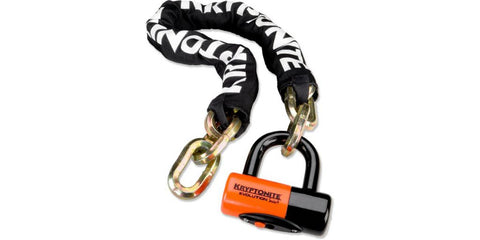One of the best ways to secure your bike from being stolen is a bike lock. You might even need two bike locks depending on where and what you have to lock it too. But, not all bike locks will do the job. All bike locks can be broken, but choosing the right lock for your bike and for you will help deter bike thieves.
U-Locks
This widely used bike lock style is an excellent deterrent. The bulky locking mechanism resists hammers, chisels , etc. Its horseshoe shape can limit leveraging—provided it's not way oversized for the bike. The goal is to reduce the amount of space in which a thief can insert a crowbar and leverage enough strength to break it apart.
U-locks come in various sizes. Your goal is to size the lock so that it goes around the things you’re locking with as little gap left as possible. Small to medium models lock one wheel and your frame to a fixed object. Large models lock both wheels and your frame to a fixed object.
Cable Locks
These are versatile and adaptable but generally offer less theft deterrence than U-locks. Unfortunately, bolt cutters are able to cut through most cable locks. On their own, they may be suitable for low-crime areas. Elsewhere, try using it in combination with a U-lock to secure easily removed parts. Many have integral combination or key locks; others require a separate padlock. Some feature sliding sizing or an armored coating. A few newer models feature stylish designs.
Chain Locks
Tough enough for high-crime areas, these bike locks use a specially designed chain link that resists hacksaws or chisels and makes the chain tough to leverage. Be sure to invest in a padlock that's just as sturdy—thieves can easily cut through thin locks, no matter how sturdy the chain. The downside? Chains are heavy and bulky, so they are best for stationary uses.
Bike Lock with Keys or Combinations
Keyed locks use either flat keys or cylindrical keys. Cylindrical keys got a bad reputation in years past when it was discovered some locks of this style could be picked by a ballpoint pen. Newer models have solved that problem so it's more effective.
Keyed bike locks usually come with at least 2 keys so you’ll have a backup. Most bike lock makers have a key replacement program if you lose your keys.
Keyed locking mechanisms are found on most U-locks and some cable and chain locks.
Combination locks are convenient because you don’t have to remember to carry a key with you or worry about losing keys, but you do have to remember a 4-digit code.
Cable locks typically use a combination locking mechanism.
If you have more questions or would like to chat with our product experts visit us on line or email us at info@BicycleWarehouse.com.
Bike Theft Prevention Tips
- A lock is your first defense when it comes to preventing bike theft, but it's not the only way to protect your ride. Buying the best bike lock out there won't help if you forget to lock up your bike in the first place.
- Keep your lock on your person when commuting, and lock it up even if you're heading inside a building for just a few minutes.
- Using two or more bike locks can help secure your bike even further. More than one lock will make your bike a lot less appealing to potential thieves.
- And don't forget to secure your wheels and other removable peripherals, especially on a fancy road bike. Thieves will be none too happy to walk away with easy to grab tires.
- Avoid the all too common mistake of only locking up your wheel. Make sure to secure your frame! If you'd rather not spend additional dollars on extra locks, take removable parts like wheels, panniers, and lights with you.
- When you're locking up your bike, leave as little space as possible between the lock and your bike. That makes it much harder for would-be thieves to gain leverage when trying to cut off a lock. Don't lock up your bike in a low-traffic area. That makes your sweet ride a sitting duck. Try not to leave it overnight, either.
- After you've locked it up, make sure to verify that it's actually locked. Being paranoid is okay — it's your ride!
- Don't be shy, head over to your local police station and ask to register your bike. It'll make it easier to find you, the original owner, should the bike get stolen and find its way to law enforcement.









